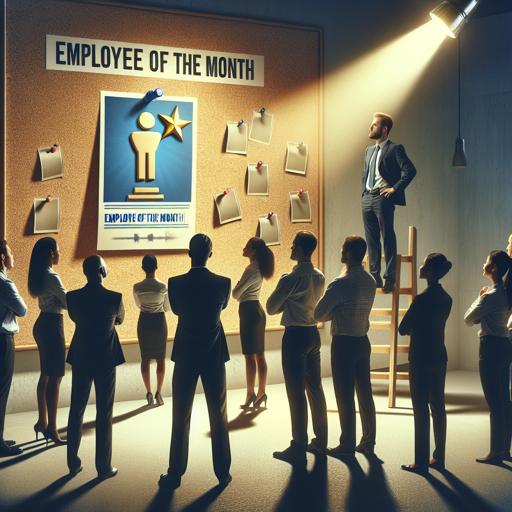In today’s fast-paced business environment, workplace recognition has emerged as a pivotal element in fostering motivation among employees. As organizations strive to maintain a competitive edge, acknowledging the efforts and achievements of their workforce has become more critical than ever. Workplace recognition not only boosts morale but also cultivates a culture of appreciation and respect, leading to increased productivity and job satisfaction.
By understanding the role it plays in motivation, companies can harness the power of recognition to inspire their teams, drive performance, and ultimately achieve their strategic goals. Join us as we explore the transformative impact of workplace recognition on employee motivation.
Understanding workplace recognition: definitions and importance

In the bustling world of corporate endeavors, workplace recognition often performs the clandestine role of the unsung hero, living quietly between the lines of emails and lodged firmly within an approving nod. This practice is not merely a ceremonial pat on the back but serves as the lifeline boosting employee morale and propelling motivation.
When employees feel acknowledged for their contributions, they are granted a powerful affirmation of their value within the organization. This acknowledgment transforms the routine into an environment where individuals feel driven to excel not just for their benefit but also for the company at large. Through the lens of motivation, recognition becomes the magic wand that conjures a thriving and participative workforce, fostering an atmosphere where every good deed begets another.
Consider an employee who spends late nights and early mornings perfecting a presentation for a high-stakes meeting; a simple acknowledgment of their effort can empower them to embrace challenges with even greater passion and vigor. Recognition transcends a mere thank you, operating instead as a strategic element of employee engagement and productivity elevation. It encourages a ripple effect, inspiring other team members to emulate such behaviors, thereby creating a culture grounded in excellence and dedication.
Workplace recognition is indeed the catalyst that transforms potential into performance, an alchemical process whereby acknowledging small victories today lays the groundwork for significant achievements tomorrow. With the right encouragement, employees become not just participants but innovators, carrying their organizations to new heights with every appreciative nod, gesture, or thoughtfully selected word.
The psychological impact of recognition on employee motivation

In the world of work, acknowledging an employee’s contributions can be likened to adding a dash of zest to an otherwise bland dish. An often underestimated yet powerful catalyst, acknowledging workplace efforts serves as a vital ingredient in stirring motivation and boosting morale. Consider the workplace as a stage where each employee performs their role.
When the curtain falls, recognition acts as the applause that compels an encore, invigorating the performer to deliver an even more stellar act next time. It’s not just about meeting quotas or achieving KPIs.
It grabs the essence of work culture, transforming mundane tasks into meaningful expressions of value. This recognition instills a sense of belonging and pride, subtly weaving itself into the tapestry of an employee’s motivation.
For instance, a study might reveal that employees who often receive commendations are less likely to sneak a peek at job openings on their lunch breaks. Instead, they channel their creative energies into the company they feel recognized by, striving to exceed expectations. It fosters an ecosystem where employees are emboldened to innovate, knowing their efforts will not vanish in obscurity.
A culture of recognition cultivates leaders who are not just managers of tasks but champions of talent, seeing not just their own ambitions fulfilled but also nurturing the aspirations of their team. Ultimately, weaving recognition into the very fabric of company culture ensures that no employee’s efforts go unnoticed, making commitment and motivation not just conceivable ideals but everyday realities in the workplace.
Different forms of workplace recognition and their effectiveness

In a world where free coffee and a lively ping-pong table often serve as popular symbols of employee appreciation, understanding the nuanced art of workplace recognition can be the secret weapon in the arsenal of employee motivation. Picture this: a realm where accolades come in various intriguing forms—be it an unexpected handwritten note from the boss, a shoutout during a team meeting, or an „employee of the month” parking spot so close you can smell it. Each of these recognition forms holds significant value, crafted specifically to resonate with different individuals and ignite their professional drive.
Yet, the disparity in their effectiveness is not just in the delivery but in their capacity to foster individual motivation and cultivate a culture of acknowledgment and engagement. Imagine an organization where the employees know their efforts are as visible as their performance stats on the office dashboard.
In such places, personalized thank-yous and strategic public recognitions have transformed the banal work environment into a breeding ground for innovation, creativity, and loyalty. For instance, symbolic rewards like an engraved trophy don’t just serve as dust collectors; they become permanent reminders of one’s hard work and creativity, and effectively fuel the intrinsic motivation that pushes employees to surpass their limits.
On the flip side, performance bonuses or days off might speak directly to extrinsic motivation, offering tangible incentives that reinforce productive behaviors and encourage sustained effort. In this multifaceted beauty of workplace recognition, the ultimate effectiveness hinges on authenticity and consistency. Beyond mere gestures, recognition should resonate on a deeper level, echoing within the corridors of an employee’s purpose and aspirations.
Ensuring recognition is personalized and timely is key to its success; when recognition aligns with personal values and career goals, it reinforces an environment where intrinsic and extrinsic motivations mutually flourish. The clever deployment of recognition, thus, not only serves as a performance catalyst but also as a cornerstone for cultivating a motivated and robust workforce. By understanding the rich tapestry of recognition, leaders can weave together a narrative of success and satisfaction, where each employee feels understood, valued, and motivated to contribute their best to the collective goal.
The role of leadership in fostering a culture of recognition
The unmistakable sound you just heard might be the collective sigh of relief from employees everywhere when a leader transforms the mundane outpost of their workplace into a vibrant ecosystem of acknowledgment. The magic ingredient? Savvy leadership keen on knitting together an unspoken tapestry of appreciation that resonates across cubicles and boardrooms alike.
Cultivating this culture of commendation is no mere feat, but when executed with finesse, it acts as a powerful catalyst in amplifying motivation across the organization. People thrive on recognition; it’s the fuel that drives an otherwise weary engine.
When leadership steps up with the astuteness of an orchestra conductor, ensuring that each player is noted—not just noticed—motivation flourishes and soars, not unlike a magnificent crescendo. Aligning recognition with strategic motivational endeavours is critical, for it’s what metamorphoses routine tasks into passion-driven pursuits.
Leadership’s role here is to design and nurture an environment where appreciation flows naturally, changing the game from a thankless hustle to a celebrated journey. By seamlessly embedding recognition into the organizational fabric, leaders place themselves at the core of influential change. Consider the case of tech maestros who, amidst the clamor of innovation deadlines, spotlight the unique contributions of their teams.
It’s not just about doling out trophies or applause; it’s about embedding a sense of purpose that emboldens employees to innovate and excel, motivated both by praise and potential. This is no accident—it’s leadership finesse in tipping the motivation scale toward greater productivity and satisfaction. Inspiring a culture of recognition involves more than just awards resting dust-laden on shelves; it is the daily nods, the sincere accolades, and the earnest acknowledgments that hold true merit.
Leaders must practice a sort of earnest omniscience, seeking opportunities to celebrate even the smallest of victories, and in doing so, underline the significance of each role within the organizational cosmos. Imagine the ripple effect of a leader who, with impeccable timing, acknowledges the backend developer for a particularly knotty bug fix.
The result? A ripple of motivation that extends far beyond a single task or individual. This clever alchemy—wrought through strategic recognition—transforms the workplace into a haven of engagement, with motivation not just enhanced but entrenched as a lasting tenet. Through leadership’s deft orchestration, recognition ceases to be a mere footnote and emerges as a cornerstone in the grand narrative of workplace excellence.
Measuring the impact of recognition programs on employee performance and retention
In the fast-paced landscape of corporate management, where every decision seems to hinge on the mystical alchemy of strategy and innovation, there is one element that often gets sidelined: the art of recognition. Yet, workplace recognition acts as the unsung hero, wielding the power to transmute an ordinary work environment into a thriving ecosystem bursting with motivation and engagement. When employees receive genuine acknowledgement for their contributions, it’s akin to a well-timed encore in a gripping performance, where motivation soars and productivity levels don playful wings.
Recognition isn’t just a pat on the back; it’s a robust catalyst that revitalizes vigor and propels morale to dizzying heights. Indeed, the strategic implementation of recognition programs can have a profound ripple effect on employee performance and retention.
The concept is simple yet powerful—commendation and appreciation instill a sense of belonging and purpose, crucial elements in nurturing a motivated workforce. Companies that excel in acknowledging their team members’ efforts find that their employees are more inclined to go above and beyond, driven by a renewed commitment to sustaining and elevating operational excellence. Employee retention rates, too, experience an uplift, as recognition fosters a positive workplace culture where individuals feel seen and valued, reducing the churn of top talent like a seasoned sorcerer waving a wand.
Recognizing contributions is not solely about handing out accolades or awards; it’s about embedding a culture where appreciation is as natural as breathing. When managers take the initiative to celebrate successes—whether during grand meetings or via simple yet sincere notes—employees are more likely to replicate the behaviors that led to such recognition.
This creates a virtuous cycle where motivation fuels performance, and enhanced performance feeds recognition, galvanizing the entire workforce into a seamless, harmonious dance of collaboration and creativity. What’s more, in times when attrition can cost companies dearly, investing in recognition is akin to purchasing a premium insurance policy, safeguarding the most critical asset: human capital.
Nasza rekomendacja wideo
Podsumowanie
Workplace recognition is a powerful motivator that enhances employee engagement, productivity, and job satisfaction. By acknowledging individual and team achievements, organizations foster a positive work environment and encourage continuous improvement. Effective recognition strategies not only boost morale but also contribute to employee retention and loyalty, ultimately driving organizational success.
Prioritizing recognition can transform workplace culture and motivate employees to perform at their best.
Najczęściej zadawane pytania
How does workplace recognition impact employee motivation and overall job satisfaction?
Workplace recognition boosts employee motivation and overall job satisfaction by validating efforts, enhancing morale, and fostering a positive work environment.
Sure, please provide the question you’d like me to answer.
What are the most effective forms of recognition that can boost motivation in the workplace?
The most effective forms of recognition that can boost motivation in the workplace include personalized praise, public acknowledgment, and tangible rewards that align with employees’ values and contributions.
Of course! Please provide the question you’d like me to answer.
How can managers and leaders implement a culture of recognition to enhance team performance?
Managers and leaders can implement a culture of recognition by consistently acknowledging and rewarding individual and team achievements, fostering an environment of appreciation and motivation.
Sure, please provide the question you would like me to answer.
What are the potential consequences of a lack of recognition on employee morale and productivity?
A lack of recognition can lead to decreased employee morale and productivity, resulting in disengagement, higher turnover rates, and reduced overall performance.
Sure, please provide the question you’d like me to answer.
How does personalized recognition differ from generic recognition in terms of motivating employees?
Personalized recognition specifically acknowledges an individual’s unique contributions and strengths, making it more meaningful and motivating than generic recognition, which often lacks personal relevance and impact.
Of course! Please provide the question you’d like me to answer.
What role does peer-to-peer recognition play in fostering a motivated and engaged workforce?
Peer-to-peer recognition fosters a motivated and engaged workforce by creating a supportive and inclusive environment where employees feel valued and appreciated, enhancing morale and collaboration.
